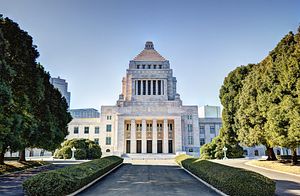There have been several new leaks about the make-up of the Japanese government’s new Cabinet, expected to be announced on Wednesday. The new Cabinet is shaping up to simply be a reshuffle of top LDP members, as minsters that are deemed important for implementing Prime Minister Shinzo Abe’s key economic, security and foreign policies will either retain their current positions or simply take on different posts within the administration or party’s leadership. However, there will be a few new faces in the administration, as Abe is also seeking to both include more women and also elevate party members who have served more than four terms. Additionally, it appears that the all-important question of what will happen to LDP secretary general Shigeru Ishiba has been settled, and that he will agree to join the Cabinet.
With just two days left before the Cabinet is officially announced, the government is airing several names for possible positions as it attempts to gauge public reaction and also negotiate the last few posts. Government sources who spoke with the Jiji Press indicated on Sunday that Masahiko Komura will remain vice president of the LDP. Komura is considered trustworthy by Abe as he was primarily responsible for the successful negotiations with coalition partner New Komeito over the Cabinet’s new interpretation of the right to collective self-defense.
Abe is also considering Yuko Obuchi, formerly the minister in charge of overseeing Japan’s declining birth rate, to replace Ishiba as the LDP’s secretary general. This would put a woman in the LDP’s second most powerful position, just below Abe himself. Government sources who spoke with the Yomiuri Shimbun stated that Abe is attempting to form consensus within the party over her appointment “by confirming the wishes of the leadership of the LDP’s Nukaga faction to which she belongs.”
The new Cabinet post of minster in charge of security legislation, which will be tasked with guiding legislation on collective self-defense through the Diet (and which was also the position that Ishiba initially declined), will be given to former Parliamentary Senior Vice Defense Minister Akinori Eto. He served in that capacity during Abe’s previous premiership, and is also expected to serve as defense minister in the new government. According to the Yomiuri, Eto is part of a party faction headed by Tadamori Oshima, and that fellow faction member Komura recommended Eto for the position after Ishiba declined the new security legislation post. Both Eto and Obuchi have been elected by their constituencies five times.
Finally, after significant back-channel wrangling and allegations that Ishiba would remain out of the new government entirely in order to challenge Abe for the post of LDP president in the fall of 2015, it appears that he will indeed accept a Cabinet position. Government sources said Ishiba would join the government if Abe invited him to do so, although he would not take the new security position because of differences between himself and Abe on security policy. Ishiba also told the press on Friday “The Cabinet approval rating and the support rating for the LDP are high. It’s important to maintain them. No rift has been created between the prime minister and me.” It was reported the next day that Ishiba is being considered for another new Cabinet position, that in charge of revitalizing regional economies and communities, which is another key plank of Abe’s core economic policies, or possibly the trade ministry.
Other key party placements for Abe include Ichiro Aisawa and Shunichi Yamaguchi, who have been elected nine and eight times respectively. These two men along with Eto have never held a Cabinet level position. Obuchi would be the first woman to hold the position of LDP secretary general, and in addition she is the second daughter of former Prime Minister Keizo Obuchi. All four of these people have important ties within the party that Abe must satisfy. Aisawa is the longest serving LDP member to never hold a Cabinet position, yet has served as lower house committee chairman and chair of the Diet affairs committee, Obuchi has familial connections to be considered, and Yamaguchi is part of the LDP faction led by Deputy Prime Minister Taro Aso, who then suggested him to Abe.
The prime minister appears to be successfully balancing the different factions within his party, and most importantly to have brought a potential rival in Ishiba back into fold of the government’s leadership. If not quite on his own terms, having Ishiba take a Cabinet position would help to keep him from being publicly critical of Abe, who will now have the more difficult task of continuing to implement his key policies as his new government appointees acclimate themselves to their new jobs midstream.

































